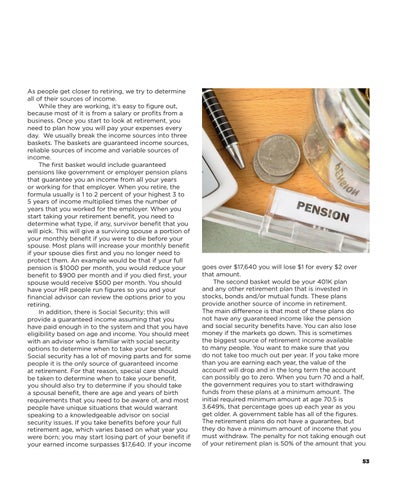As people get closer to retiring, we try to determine all of their sources of income. While they are working, it’s easy to figure out, because most of it is from a salary or profits from a business. Once you start to look at retirement, you need to plan how you will pay your expenses every day. We usually break the income sources into three baskets. The baskets are guaranteed income sources, reliable sources of income and variable sources of income. The first basket would include guaranteed pensions like government or employer pension plans that guarantee you an income from all your years or working for that employer. When you retire, the formula usually is 1 to 2 percent of your highest 3 to 5 years of income multiplied times the number of years that you worked for the employer. When you start taking your retirement benefit, you need to determine what type, if any, survivor benefit that you will pick. This will give a surviving spouse a portion of your monthly benefit if you were to die before your spouse. Most plans will increase your monthly benefit if your spouse dies first and you no longer need to protect them. An example would be that if your full pension is $1000 per month, you would reduce your benefit to $900 per month and if you died first, your spouse would receive $500 per month. You should have your HR people run figures so you and your financial advisor can review the options prior to you retiring. In addition, there is Social Security; this will provide a guaranteed income assuming that you have paid enough in to the system and that you have eligibility based on age and income. You should meet with an advisor who is familiar with social security options to determine when to take your benefit. Social security has a lot of moving parts and for some people it is the only source of guaranteed income at retirement. For that reason, special care should be taken to determine when to take your benefit, you should also try to determine if you should take a spousal benefit, there are age and years of birth requirements that you need to be aware of, and most people have unique situations that would warrant speaking to a knowledgeable advisor on social security issues. If you take benefits before your full retirement age, which varies based on what year you were born; you may start losing part of your benefit if your earned income surpasses $17,640. If your income
goes over $17,640 you will lose $1 for every $2 over that amount. The second basket would be your 401K plan and any other retirement plan that is invested in stocks, bonds and/or mutual funds. These plans provide another source of income in retirement. The main difference is that most of these plans do not have any guaranteed income like the pension and social security benefits have. You can also lose money if the markets go down. This is sometimes the biggest source of retirement income available to many people. You want to make sure that you do not take too much out per year. If you take more than you are earning each year, the value of the account will drop and in the long term the account can possibly go to zero. When you turn 70 and a half, the government requires you to start withdrawing funds from these plans at a minimum amount. The initial required minimum amount at age 70.5 is 3.649%, that percentage goes up each year as you get older. A government table has all of the figures. The retirement plans do not have a guarantee, but they do have a minimum amount of income that you must withdraw. The penalty for not taking enough out of your retirement plan is 50% of the amount that you 53
